Homemade NAS from a netbook with a reworked PCI express SATA controller for ExpressCard / 34
The article describes an unusual storage system based on a netbook with the addition of an external, reworked SATA controller and software from the XPEnology project. The DIY hub, it seems to me, is most appropriate in spirit to the project, in which technical creativity and love for geek technologies occupy the main place. I did not aim to create a full-fledged home storage system, although everything works at the proper level. For these purposes, I have been working with a real Synology NAS for several years.
So, the story of the old hardware, a soldering iron and a new software.
What was in the beginning, what interested the inquiring mind.
1. The Lenovo IdeaPad S10 netbook, which was a veteran in battles with a transplanted keyboard, lost a battery and deprived of a web-camera eye, was lying around idle. Platform based on Intel Atom N270 1.6 GHz, which ark.intel.com reports that it is a 32-bit x86 architecture. An important characteristic of this netbook is the presence of an ExpressCard / 34 slot, that is, a connector with a full-fledged PCI Express x1 bus, which is not very typical for netbooks.
')
2. Controller SATA2 RAID Espada based on SIL3132. Which, besides unnecessary RAID, has a PCI Express x1 slot.
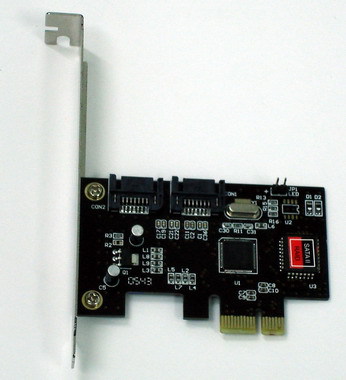
3. An almost nameless RS-232 <-> ExpressCard / 34 serial port adapter, which in fact is not a PCI Express device, but only parasitic on USB 2.0 ExpressCard / 34 connector lines. But it has a full set of contacts, and this is of particular value for the project.
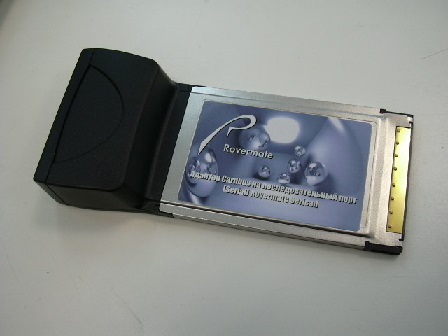
4. You will also need an external power supply + 5V, + 12V with power connectors for external hard drives. SATA power adapters. And of course a pair of HDD (after all NAS) and a flash drive ~ 1GB for the OS bootloader.
As you may have noticed, the peripherals and netbooks have a PCI Express x1 bus, but with different connectors. The incompatibility that arose on the way is solved with the mind and a soldering iron. After analyzing and comparing the pinouts for the PCIe and ExpressCard / 34 slots, the following combination scheme was drawn. There were not very many lines (the necessary connections are drawn “by hand”), so it is quite a feasible task of crossing interfaces.

We disassemble the RS-232 ExpressCard adapter, cut the unwanted USB 2.0 lines with a scalpel and, according to the scheme, gently solder the stripped cable made of 80-core IDE cable. The length of the loop can be several centimeters (about length: 18 cm PCIe risers are offered on eBay). Next, we rid the RAID controller of the iron bar and solder the second end of the loop to it according to the scheme. Adapter soldering is the most difficult moment in the whole craft; here the main thing is accuracy and straight hands that have already become a classic. This is a hybrid.
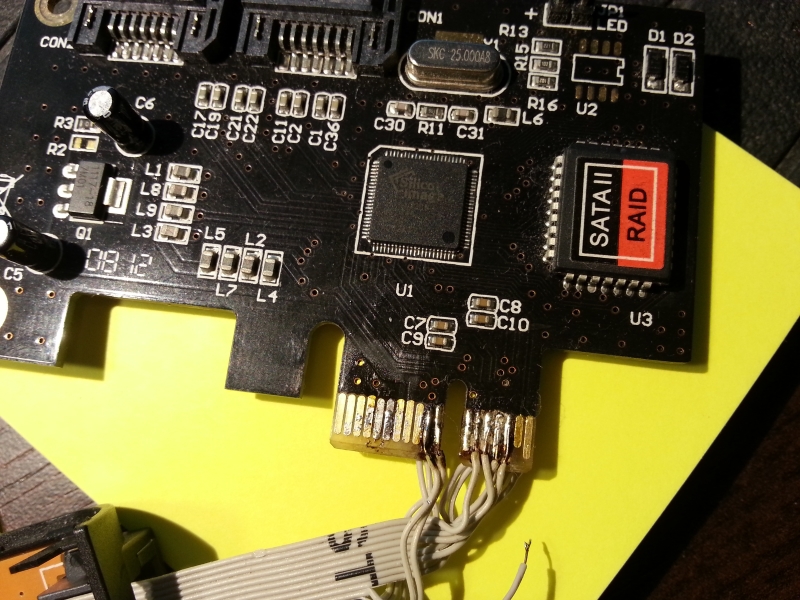
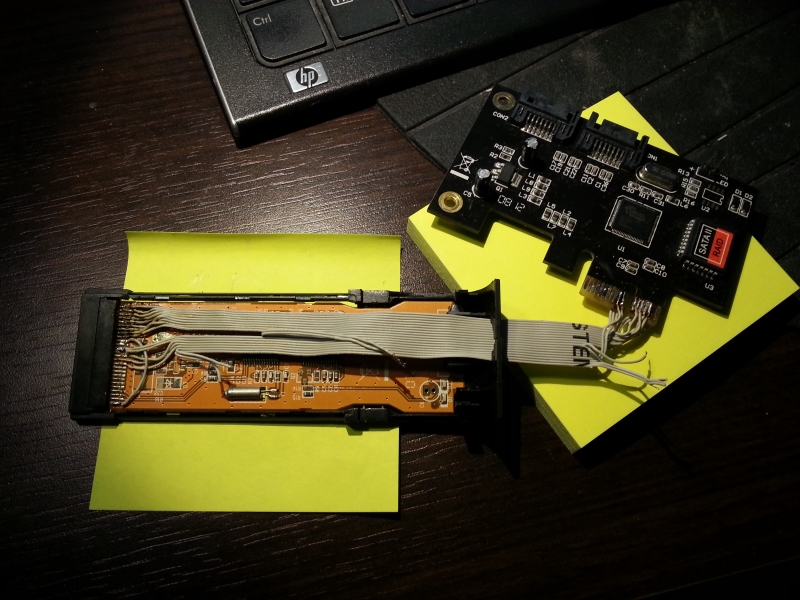
We give the product a finished look, we wind it with a blue electrical tape and fasten it with a plastic tie.
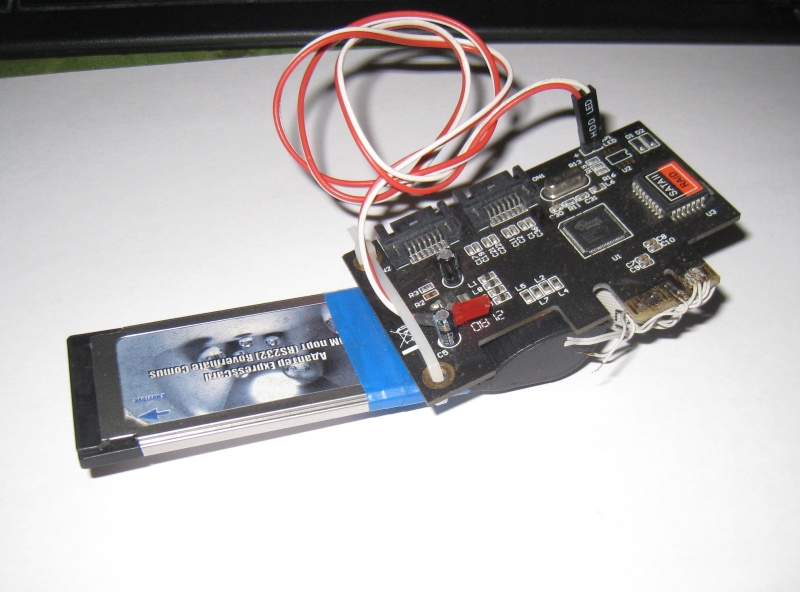
Congratulations on the successful conversion to ExpressCard / 34 SATA2 controller for two HDDs. "Drumroll". We are convinced that it is defined in the system (see video below), and that we can configure disks in the BIOS RAID menu.
This is how the entire system looks like.
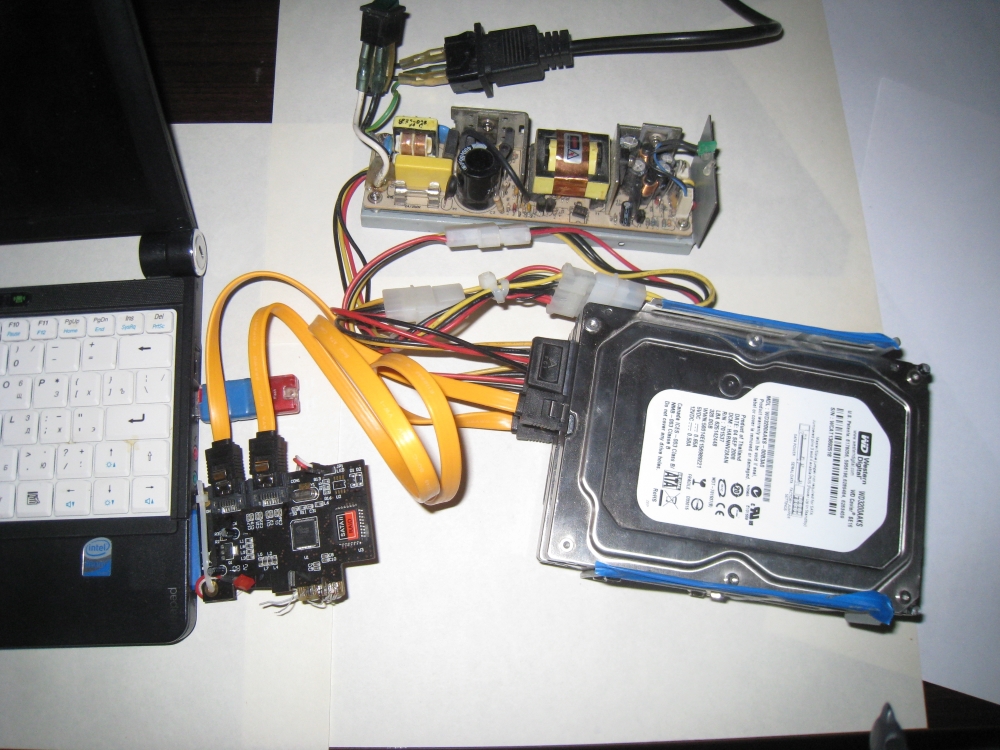
For a long time I follow the project XPEnology . The essence of which is to run Synology DSM software on third-party x86 / x64 systems. The choice of software, as such, I did not do, XPEnology was initially an integral part of future crafts.
The main branch of the XPEnology project platform is the x64 system, but there is also a weakly supported x86 branch. The latter is just interested, since the processor of the netbook, as already mentioned above, does not support x64 instructions.
The system is installed in accordance with the instructions of the project XPEnology, so I will say only a few words about what started. The NanoBoot-x86-5.0.3.2 loader was used, the final version of DSM 5.0-4528. Quite good, given the limitations of the platform. The system boots from an external USB flash drive.
For the Lenovo S10, it was experimentally revealed that the installation should be done with the internal SATA HDD disabled, otherwise DSM is incorrectly installed. After a successful start of the system, you can reconnect the internal drive.
The Lenovo S10 drives in DSM are distributed as follows:
By default, the distribution to external and internal drives in DSM does not correspond to the desired, I would like to see drives 1-3 in DSM as internal SATA, and USB drives as external USB.
To get the desired schema, you need to edit ssh using vi files /etc/synoinfo.conf and /etc.defaults/synoinfo.conf
For this you need to create the following masks for port allocation:
Running system video:
On this, allow me to bow out.
So, the story of the old hardware, a soldering iron and a new software.
This is done because it could be done!
Part 1. Handy materials
What was in the beginning, what interested the inquiring mind.
1. The Lenovo IdeaPad S10 netbook, which was a veteran in battles with a transplanted keyboard, lost a battery and deprived of a web-camera eye, was lying around idle. Platform based on Intel Atom N270 1.6 GHz, which ark.intel.com reports that it is a 32-bit x86 architecture. An important characteristic of this netbook is the presence of an ExpressCard / 34 slot, that is, a connector with a full-fledged PCI Express x1 bus, which is not very typical for netbooks.
')
2. Controller SATA2 RAID Espada based on SIL3132. Which, besides unnecessary RAID, has a PCI Express x1 slot.

3. An almost nameless RS-232 <-> ExpressCard / 34 serial port adapter, which in fact is not a PCI Express device, but only parasitic on USB 2.0 ExpressCard / 34 connector lines. But it has a full set of contacts, and this is of particular value for the project.

4. You will also need an external power supply + 5V, + 12V with power connectors for external hard drives. SATA power adapters. And of course a pair of HDD (after all NAS) and a flash drive ~ 1GB for the OS bootloader.
Part 2. Give me a soldering iron, and I will turn the world
As you may have noticed, the peripherals and netbooks have a PCI Express x1 bus, but with different connectors. The incompatibility that arose on the way is solved with the mind and a soldering iron. After analyzing and comparing the pinouts for the PCIe and ExpressCard / 34 slots, the following combination scheme was drawn. There were not very many lines (the necessary connections are drawn “by hand”), so it is quite a feasible task of crossing interfaces.

We disassemble the RS-232 ExpressCard adapter, cut the unwanted USB 2.0 lines with a scalpel and, according to the scheme, gently solder the stripped cable made of 80-core IDE cable. The length of the loop can be several centimeters (about length: 18 cm PCIe risers are offered on eBay). Next, we rid the RAID controller of the iron bar and solder the second end of the loop to it according to the scheme. Adapter soldering is the most difficult moment in the whole craft; here the main thing is accuracy and straight hands that have already become a classic. This is a hybrid.


We give the product a finished look, we wind it with a blue electrical tape and fasten it with a plastic tie.

Congratulations on the successful conversion to ExpressCard / 34 SATA2 controller for two HDDs. "Drumroll". We are convinced that it is defined in the system (see video below), and that we can configure disks in the BIOS RAID menu.
This is how the entire system looks like.

Part 3. Software
For a long time I follow the project XPEnology . The essence of which is to run Synology DSM software on third-party x86 / x64 systems. The choice of software, as such, I did not do, XPEnology was initially an integral part of future crafts.
The main branch of the XPEnology project platform is the x64 system, but there is also a weakly supported x86 branch. The latter is just interested, since the processor of the netbook, as already mentioned above, does not support x64 instructions.
The system is installed in accordance with the instructions of the project XPEnology, so I will say only a few words about what started. The NanoBoot-x86-5.0.3.2 loader was used, the final version of DSM 5.0-4528. Quite good, given the limitations of the platform. The system boots from an external USB flash drive.
For the Lenovo S10, it was experimentally revealed that the installation should be done with the internal SATA HDD disabled, otherwise DSM is incorrectly installed. After a successful start of the system, you can reconnect the internal drive.
The Lenovo S10 drives in DSM are distributed as follows:
| Disk 1 | 1st port of external SATA controller |
| Disk 2 | 2nd port of external SATA controller |
| Disk 3 | Lenovo Internal SATA |
| Disk 18 | 1st external USB drive |
| Disc 19 | 2nd external USB drive |
By default, the distribution to external and internal drives in DSM does not correspond to the desired, I would like to see drives 1-3 in DSM as internal SATA, and USB drives as external USB.
To get the desired schema, you need to edit ssh using vi files /etc/synoinfo.conf and /etc.defaults/synoinfo.conf
For this you need to create the following masks for port allocation:
# ESATA esataportcfg="0x0" # 17-20 usbportcfg="0xf0000" # 1-16 internalportcfg="0xffff" Running system video:
On this, allow me to bow out.
Source: https://habr.com/ru/post/256101/
All Articles